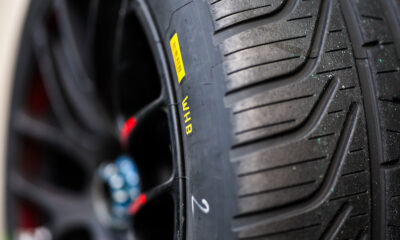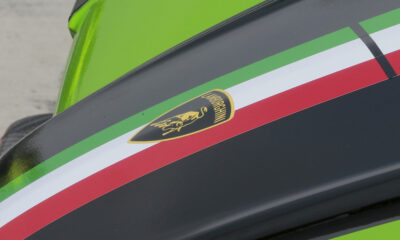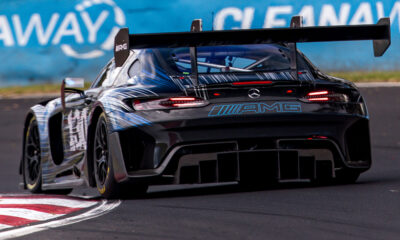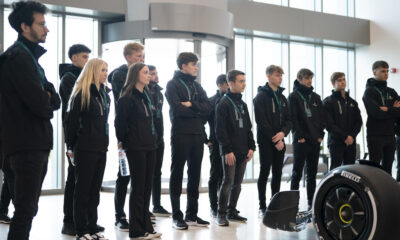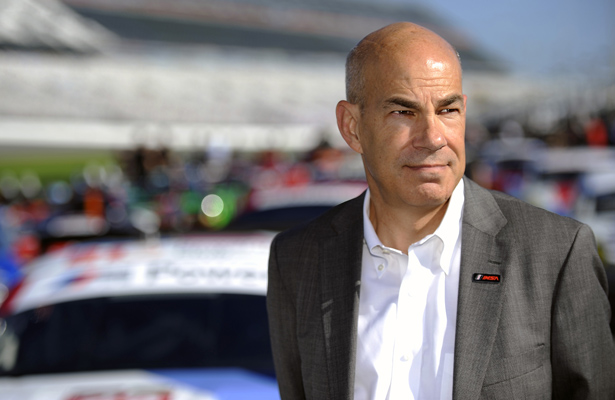
Photo: IMSA
Scott Atherton has been a driving force in the U.S. sports car racing scene for the last 15 years, having helped build the American Le Mans Series into one of the world’s premier championships, alongside founder Don Panoz, and strengthening its relationship with the ACO every step of the way.
BEHIND THE TITLE: Pierre Fillon / Stephane Ratel (Pt. 1) & (Pt. 2) / Gerard Neveu
The former Domino’s Pizza executive, who now serves as the President and Chief Operating Officer of IMSA post-merger, shares his unique career path in the first part of the latest edition of “Behind the Title.”
How did you get interested in cars?
“I had an older sister whose boyfriend drove a ’63 red Corvette. The first time he pulled up into the driveway and the windows were rattling…I was going ‘What the heck was that?’ I was maybe 5 and I literally remember walking out and looking at that car and being in awe. That triggered the car appreciation.
“As for motorports, my first race was a Trans-Am race at Seattle International Raceway in 1971 or 1972. Mark Donohue, Parnelli Jones, George Follmer… that was the pinnacle of manufacturer involvement back in Trans-Am, and I was completely taken.
“There was no history of racing in my family. My dad didn’t race but he tolerated my nagging of, ‘Let’s go to the races.’
“I was 10 or 11 years old when that first race experience occurred. From that moment on, I was completely obsessed with it. Every piece of notebook paper had a drawing of a car in it, and something along those lines.”
Did you ever race yourself?
“I did motocross racing and that’s how I got the scar on my chin. This was the day before full-faced helmets. I was 13 years old when I got a broken jaw, my teeth were knocked out… It was a bad result. My mom said no more motorcycles so I started racing go-karts, at a very high level.
“We had a family friend that was racing up and down the west coast at the top level. I was racing with Dominic Dobson, Kathy Rude, etc. I also raced against Scott Pruett a few times. We had no money and no budget and my family wasn’t in a position to continue.
“I worked multiple jobs, and by 18, I was able to pay for a season of Formula Ford. We raced in Portland, Seattle, Westwood and it was one [season] and done. With no racing options, I went to college with the idea that I’d get a degree that would help me work in the industry, but resigning myself of being a professional race car driver.”
You then shifted your focus to making a career out of motorsports?
“During college, I worked for a guy in Seattle that was racing Super Vees. He hired Mike Hull to be the team manager. Mike and I did a season of Super Vees in a fifth-wheel rig.
“My dad was friends with the sponsor of Tom Gloy. I’m halfway through college and I went to the Long Beach Grand Prix and walked up to Tom Gloy and introduced myself and said I’ll work for free.
“I remember his response. ‘You’ll work for free? I can’t afford you!’ What do you say to that? A few weeks later, I’m at school and I get a message from a professor who says, ‘Scott Atherton: Please come see me for an important message.’
“I walk down to the front of the class and I found out I need to call home. It was my mom, who told me Tom Gloy had just called and got an opportunity but I’d have to move to California, and start the following week.
“I quit college and traveled for an entire season of Formula Atlantic. It gave me the opportunity to meet all of the people that ultimately became CART. Unlike what my parents thought would happen, it had the reverse effect.
“I spent a season as a truckie working my tail off and realized I wanted to be the manager of the process and not the crew member. So I went back to college and was never more motivated to get a degree and move on. I got a business degree in marketing and communications from University of Washington.”
That led to the big break with Domino’s Pizza…
“There were two big sponsors in road racing that time, Domino’s Pizza and Marlboro. I didn’t smoke, and for me it wasn’t a good fit, so I set my sights on Domino’s, only because they were a sponsor that appeared to do everything with their motorsports involvement.
“A friend of a friend of a friend was dating a girl that worked for Domino’s. I wrote a letter, saying I’ll do anything, just trying to get in the door. I got a phone call offering me to be a show car truck driver. I took it because all I needed to do was get in the door and figure the rest out.
“I packed up everything and drove from Seattle to Ann Arbor. The first event for the show car was a display alongside the Domino’s Pizza mobile unit at the Indy 500. I got to meet Doug Shierson and Al Unser Jr. and all the other people involved.
“We were on to the next race at Milwaukee. I’m driving up the road and the truck had a car phone. I never had a cell phone or a vehicle that had one before. The phone rings and I pick up the handset and it’s Ron Hingst from Anthony M. Franco, the PR agency of record for Domino’s. They needed me back in Ann Arbor for a meeting at 9 a.m. the following morning.
“The next day, in a big conference room with 20 or 30 other people, it turns out Joyce Julius (VP of Marketing) and Bob Cotman (Sr. VP) were fired because the two had an affair.
“I was the only one from the IndyCar program in the room, as it was Joyce and Bob that managed the whole thing. Two hours later, I’m standing around and they put me in charge of the IndyCar program.
“Thirty days into my tenure as the show car truck driver, I’m in charge of the IndyCar program for Domino’s.
“It was 1985 and it was a multi-million dollar budget for activation. It was an amazing set of circumstances and I immediately became close friends with Doug Shierson and was able to work with senior level Domino’s Pizza executives and management.
“That launched me on an unbelievable ride in the IndyCar industry and within motorsports. At the ripe old age of 25, having that level of responsibility and exposure was tremendous. I did that for four years and realized the company, which had incredible growth, didn’t have anything to do with marketing or racing. For that reason, I felt career-wise I didn’t have anywhere else to go.
“I left the IndyCar program and marketing and went into the operations side of the business. At the end of nine years, I was one of five Vice Presidents and was responsible for a geographic region of the company and reported straight to Tom Monaghan (Domino’s co-founder).
“I moved from Seattle to Ann Arbor to Dallas to Sacramento to Seattle to Minneapolis and back to Ann Arbor with Domino’s and I was done.”
But you knew your passion was in motorsports…
“A friend called saw a classified ad for President/General Manager of Laguna Seca. I threw a resume in and I was one of 750 respondents and went through an unbelievable process that took months to come to fruition.
“I was given the opportunity to take on that role [at Laguna Seca], took a 50 percent pay cut and relocated a young family of four to Monterey. I had an incredible five-year run and I used to say jokingly that the only way I’d consider leaving would be if Roger Penske called me and asked me to run one of his tracks.
“That’s what happened. I became the President and General Manager of Nazareth Speedway, [with the idea of moving to Denver for Penske’s new track, which didn’t materialize]. Instead, eighteen months later, I moved back to California to open up California Speedway [now Auto Club Speedway].
“Penske Motorsports later became acquired by International Speedway Corporation and that had a significant effect on the business.
“Shortly after, Ralph Sanchez called me and asked me if I ever heard of a guy named Don Panoz… Ralph said I was the only guy that he could think of that could help him out with his projects, including the American Le Mans Series.
“For the first time in my career, an opportunity to be a part of something like that was really intriguing. I went to work for Don in 1999 and was employee No. 1. Everyone else was an independent contractor. It was literally an empty office and a desk. There was no infrastructure and no staff. And that’s how we started.
“For the next 13 years, I worked shoulder to shoulder with Don to build the American Le Mans Series, Road Atlanta, Sebring, and Mosport, IMSA, Van Diemen and Elan. It was mind-numbing at the number of things that took place.
“Then of course there was the impromptu meeting with Jim France at an ACCUS meeting in February of 2012, which ultimately resulted in bringing the whole organization to where it is today.”
Stay tuned for Part 2 on Thursday




















